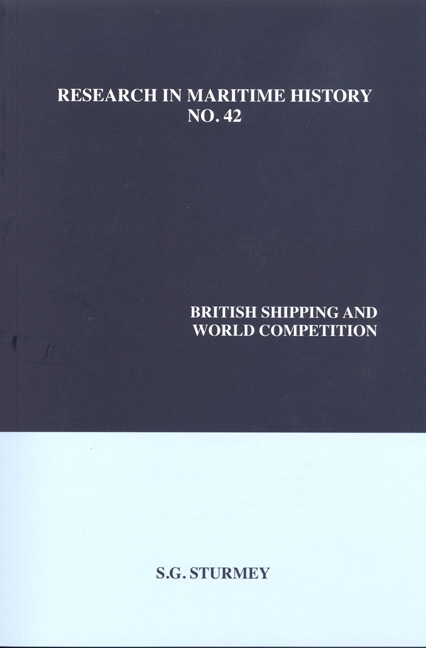Book contents
- Frontmatter
- Table of Contents
- Series Editor's Foreword
- About the Author
- Preface
- Figures and Tables
- Chapter 1 The Problem Defined
- Chapter 2 High Water: The Pre-1914 Period
- Chapter 3 War and Reconstruction
- Chapter 4 The Troubled Years: The Interwar Period
- Chapter 5 Nationalism in Shipping in the Interwar Years
- Chapter 6 The Birth of the Liberty
- Chapter 7 The Prosperous Age: The Postwar Period
- Chapter 8 Enemies of Competition in the Postwar Years
- Chapter 9 Flags of Convenience
- Chapter 10 Economics of Shipping Enterprises
- Chapter 11 Shipowning and Resource Allocation
- Chapter 12 Labour Relations and Labour Costs (by Basil Mogridge)
- Chapter 13 The Conference System
- Chapter 14 The Structure of the British Industry
- Chapter 15 The Question Answered
- Epilogue The Future
- Appendix The Contribution of British Shipping to the Balance of Payments
- Bibliography
- Index
Chapter 12 - Labour Relations and Labour Costs (by Basil Mogridge)
- Frontmatter
- Table of Contents
- Series Editor's Foreword
- About the Author
- Preface
- Figures and Tables
- Chapter 1 The Problem Defined
- Chapter 2 High Water: The Pre-1914 Period
- Chapter 3 War and Reconstruction
- Chapter 4 The Troubled Years: The Interwar Period
- Chapter 5 Nationalism in Shipping in the Interwar Years
- Chapter 6 The Birth of the Liberty
- Chapter 7 The Prosperous Age: The Postwar Period
- Chapter 8 Enemies of Competition in the Postwar Years
- Chapter 9 Flags of Convenience
- Chapter 10 Economics of Shipping Enterprises
- Chapter 11 Shipowning and Resource Allocation
- Chapter 12 Labour Relations and Labour Costs (by Basil Mogridge)
- Chapter 13 The Conference System
- Chapter 14 The Structure of the British Industry
- Chapter 15 The Question Answered
- Epilogue The Future
- Appendix The Contribution of British Shipping to the Balance of Payments
- Bibliography
- Index
Summary
In the preceding chapters the effects of differences in wage costs on the economics of operating different types of ships were considered theoretically; the purpose of this chapter is to examine the relevant data with a view to discovering, in so far as it is possible to do so, what their effect has in fact been. The chapter is concerned throughout with sea-going labour only. First, the labour relations system is reviewed and then its working is examined in terms of a single, albeit major, criterion: the strike record. Labour supply and labour costs, the latter with particular reference to the differences between costs under different flags, are then considered. Finally, there is a brief summing-up and overall assessment.
Where international comparisons are made in this chapter the most frequent example taken is that between Britain and Norway. As has been pointed out in earlier chapters, the comparison with Norway is of particular interest since the shipping of that country has not enjoyed subsidies or flag discrimination in its own favour and has been subject to very much the same external vicissitudes and disabilities as the British fleet.
The Labour Relations System
(a) Its Origins
For years British shipping was plagued by an unceasing and bitter struggle between the principal organizations on the two sides - the Sailors’ and Firemen's Union (founded in 1887) and the Shipping Federation (1890). The years 1888-1890 saw the upswing of the trade cycle, and the new union prospered beyond all expectations. In consequence, owners representing a majority of the country's merchant tonnage came together in 1890 to form a Federation with the express purpose of combating the union and in particular of preventing it from holding a monopoly of the labour supply. The first few months of the Federation's existence coincided with a turning of the economic tide. In the depression which followed the Federation developed a highly efficient strikebreaking apparatus and in port after port managed to secure a monopoly of the labour supply for itself. By the end of 1893 the union's power was broken; indeed, in the three years from 1891 to 1894 its membership (as affiliated to the Trades Union Congress) fell by over ninety-three percent.
- Type
- Chapter
- Information
- British Shipping and World Competition , pp. 237 - 270Publisher: Liverpool University PressPrint publication year: 2009



